West Berkeley's Air Quality: Don’t Ask, Don’t Tell
L A Wood, Berkeley Daily Planet August 28, 2007 |
The lyrics “you don’t need a weatherman to know which way the wind blows” have certainly been true in West Berkeley where foundry emissions and their noxious odors are a daily reminder of our local air quality crisis. Current levels of airborne chemicals and metal particulates have given zip code 94710 the shameful distinction of having some of the highest levels of asthma in the county.
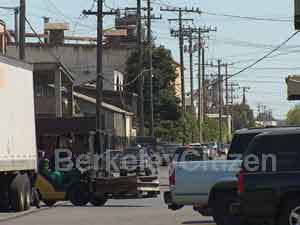 Although West Berkeley is located at the eastern edge of the San Francisco Bay, it has much poorer air quality than is found in larger California cities such as San Jose or even San Francisco. Despite numerous local advocacy groups, and even several lawsuits, this environmental outrage has only grown. The shocking truth is that today’s residents of the Oceanview district know little more about the health impacts from these industrial emissions than locals knew a quarter of a century ago.
Although West Berkeley is located at the eastern edge of the San Francisco Bay, it has much poorer air quality than is found in larger California cities such as San Jose or even San Francisco. Despite numerous local advocacy groups, and even several lawsuits, this environmental outrage has only grown. The shocking truth is that today’s residents of the Oceanview district know little more about the health impacts from these industrial emissions than locals knew a quarter of a century ago.
The deepening concern over these persistent toxic emissions has residents and workers in our community pointing blame at the area’s number one polluter, Pacific Steel Casting. Other citizens identify this problem with our inept regional air authority, the Bay Area Air Quality Management District, and still others with the City of Berkeley’s failed zoning practices that have allowed housing and offices to be located in close proximity to the steel foundry.
Although all these entities are culpable, it is clearly the air district that bears the most responsibility. For decades, BAAQMD has fostered a regulatory climate in West Berkeley of “Don’t ask, don’t tell,” and in doing so, has perpetuated an ongoing health quandary.
Regulatory hot spot
Modern-day air regulation came into existence more than 50 years ago as did our regional air district, BAAQMD. From the very beginning, the air district’s mandate has been mired in politics, allowing industrial polluters to “regulate” themselves, and as in Berkeley, to avoid any real public review or accountability.
BAAQMD, like so many other regulatory agencies, has lost sight of its prime objective to protect the public’s health and instead has preferred to protect private industry from any substantial changes. Pacific Steel Casting, at Gilman and Second Street, is a prime example of the air district’s failure to regulate.
Proof of this lies in the fact that over the past five years PSC’s production levels have increased enormously as have their airborne contaminants such as manganese, zinc, nickel, copper, cresols, phenol, benzene and formaldehyde. Yet, these emissions continue to be poorly monitored and inadequately contained. According to the California Air Resources Board data, the emissions for of some PSC airborne pollutants (benzene, copper, cresols, phenol, and zinc) have increased by over 160 percent. PSC’s manganese and Nickel emissions increased 51.6% during this period, formaldehyde increased 127.2%, lead increased by 128.5%, total particulates by 13.7% and pm 2.5 by 11%.
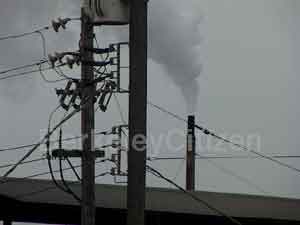 Under growing public pressure, BAAQMD has only recently begun to acknowledge this issue surrounding PSC’s emissions. For those living and working near PSC, the air district’s response has come very late in the game. In answer to its critics, BAAQMD has now required PSC to update its 16-year-old Health Risk Assessment (HRA).
Under growing public pressure, BAAQMD has only recently begun to acknowledge this issue surrounding PSC’s emissions. For those living and working near PSC, the air district’s response has come very late in the game. In answer to its critics, BAAQMD has now required PSC to update its 16-year-old Health Risk Assessment (HRA).
One can only wonder why the district took so long to determine that a new assessment was needed for the foundry. Certainly, every regulatory definition of emissions “hot spot” should have triggered this health review years ago, especially given Pacific Steel’s expanded operations, new pollution sources, and increased emissions.
Unfortunately, an updated HRA will never provide reliable answers to the many questions regarding adequate health protection of the community. The promised risk assessment, now months overdue, is tainted by the fact that it lacks any independent or impartial review. Paid for by the polluter, PSC, this “selective” investigation will only continue to justify the foundry’s polluting activities. Rarely do HRAs accomplish any more than this.
The smoking gun
Residents and workers, who have been left gasping for some regulatory relief, may now be finding this in the form of a community grant from BAAQMD. Perhaps to get some relief of its own from the public’s growing anger, the air district agreed several months ago to fund an air study centered on the foundry’s metal particulate emissions.
The district’s grant of $25,000 was awarded to Global Community Monitoring (GCM), an international environmental justice group. Despite decades of complaints and health concerns about Pacific Steel’s emissions, the West Berkeley Community Monitoring Project provides the first systematic air sampling in Oceanview.
Since May, a small team of volunteers, in conjunction with GCM, has climbed all over residential rooftops in West Berkeley, positioning portable air samplers downwind from PSC. The project has been sampling PM 10 particulate matter (10-micron diameter) for evidence of several metals common to PSC’s emission inventory.
It certainly didn’t take a giant leap of logic to hypothesize that air sampling would reveal a hefty dispersion of metals from the foundry across the Oceanview area. Most who live in that district are all too familiar with the odor plumes that waft out more than a mile from the steel mill. The monitoring team now wants to know if the particulate metals travel like the odor plumes and at what concentrations.
This unprecedented effort by GCM is now beginning to answer some of these questions and has produced some astonishing data. Although laboratory results are still preliminary, the nearly two-dozen samples processed so far have shown that concentrations of PSC’s metal contaminants were highest at locations closest to and downwind from PSC. Lower, but still excessive, levels of these contaminants have also been measured more than a half a mile from the stacks of PSC. It should be noted that the monitoring project has dispelled the long-held belief that the Highway 80 is the source of Oceanview’s airborne metal emissions.
It is not surprising that manganese and nickel are showing up in high concentrations. According to the California Air Resource Board’s data, Pacific Steel Casting is the only significant industrial source of manganese in the Oceanview area. PSC also accounts for 99 percent of all industrial nickel emissions from the more than thirty West Berkeley industrial sources that come up on CARB’s radar. A health consultant for Berkeley’s community monitoring team, Mark Chernaik, Ph.D., has stated that the levels of manganese found in a sample was 10 to 20 times higher than deemed safe by the World Health Organization. Nickel was found in a sample to be “up to 330 times the U.S. EPA reference concentration for this contaminant.”
Early indications of the GCM monitoring project suggest that BAAQMD’s assumptions about the levels of PSC’s airborne metal particulates and the dispersion of these emissions may be grossly underestimated. Perhaps the GCM project will now shift public awareness from the foundry’s noxious odors to the potential dangers produced by PSC’s metal particulate emissions that cannot be detected by sight or smell.
To find out more about the West Berkeley Community Monitoring Project, please attend a press conference being held at 11 a.m. today (Tuesday, Aug. 28) at 1340 Eighth St., which is one of the sampling locations. You will have an opportunity to view the air sampling equipment and speak with the monitoring team about the project and the lab results of the samples analyzed so far. The West Berkeley project is approximately halfway complete and is scheduled to run for several more months.
Group to Announce Results of West Berkeley Air Quality Testing
Riya Bhattacharjee, Berkeley Daily Planet August 28, 2007 |
Air monitors set up by a group of West Berkeley residents in May to detect emissions from Pacific Steel Casting (PSC) reveal high levels of toxic metals nickel and manganese.
The group, which calls itself the Berkeley Community Monitoring Team, is scheduled to present its results at a press conference at a monitoring site on Eighth Street today (Tuesday).
Pacific Steel contends that the test results are inconclusive and misleading.“The results as published by the Berkeley Community Monitoring Team ignore data that does not fit its preconceptions,” a statement issued by PSC said. “The team singles out PSC as the sole source of emissions when air samples tested are cumulative of all sources (including Highway 80) in the industrial neighborhood of West Berkeley. The air monitoring machine is not approved by the EPA, results are not verified by the Bay Area Air Quality Management District, and the machine has limited capability in detecting small amounts of individual metals.”
Located at 1333 Second St., PSC produces steel castings that are used in various industries. Area residents have complained for years about its noxious odors and emissions which they call a health risk.
“These are preliminary findings but one of the goals is to daylight our monitoring project and encourage other people to stand up on their roofs and put up a monitor,” said L A Wood, who is part of the team. “We went into it with some basic assumptions. Some of the prior sampling by the West Berkeley Alliance for Clean Air and Safe Jobs show traces of formaldehyde and lead and this raised questions in the community. I think our results will seriously challenge Pacific Steel’s Health Risk Assessment Report and urge them to take another look at it.”
Pacific Steel presented its Health Risk Assessment report to the air district last month. The report—which is yet to be released to the public—will help determine whether the steel foundry poses a health risk to Berkeley residents.
Wood added that while the air district had supported their project, Pacific Steel had not cooperated.
“We wanted to know their times of operation but were unable to do so,” he said. “We knew it was primarily at night so we based our sampling on that assumption. One of the main indicators was the smell. Every time you talk about West Berkeley emissions, the city government has pointed to the freeway. But this has more to do with all the industries in West Berkeley than the freeway. There’s a reason why the air district gave us the money for the monitors. They know that something is wrong at the steel foundry.”
The preliminary results from the community air monitor are based on two dozen samples. The final report will be released after 100 air tests have been completed.
“These test results are even more proof that Pacific Steel must immediately stop its pollution that threatens the health of the community,” said Bradley Angel, executive director of Greenaction for Health and Environmental Justice. “The health of residents is more important than corporate profits.”
According to Mark Cherniak, an independent international health expert, the levels of nickel and manganese found in the samples taken near the West Berkeley steel foundry were hundreds of times higher than considered safe by the World Health Organization (WHO).
“The nearest and largest facility known to emit these metals is Pacific Steel,” said Wood.
“At the locations where monitoring found excessive levels of both manganese and nickel, these levels were found in proportions similar to PSC’s known emissions of these metals.”
Cherniak’s analysis stated: “The manganese levels at the 700 block of Gilman Street were four to five times the WHO’s guideline value for this contaminant while nickel levels at this location were 180 to 220 times the U.S. Environmental Protection Agency’s reference concentration for this contaminant.”
Additionally, “Manganese levels at the 600 block of Gilman Street and the 1300 block of 3rd Street were 10 to 20 times the WHO’s guideline value for this contaminant while nickel levels at these locations were up to 330 times the U.S. Environmental Protection Agency’s reference concentration for this contaminant.”
Cherniak also said that all that data from the sampling suggests that PSC was the source of these excessive levels of contaminants.
“By using a mobile monitoring station, we are for the first time getting an idea of the particular pollution coming from Pacific Steel,” Denny Larson, director of the non-profit Global Community Monitor, an organization that promotes environmental justice and human rights for communities, told the Planet.
“So far, complaints have always centered around odor. There has never been a comprehensive study of tiny particles eliminated from the foundry which people can’t smell or see. We want to put some scientifically incredible numbers to these particles so that people know how big of a health risk they can be. We are finally honing in on what is harmful.”
Nonprofit’s Data Shows Pollutants Near Foundry
Robert Balicki, Daily Californian, August 29, 2007 |
Metals linked to neurological and respiratory problems were detected up to a mile downwind of a West Berkeley steel foundry, according to preliminary data released yesterday by an environmental advocacy group.
The study by Global Community Monitor measured airborne concentrations of manganese, nickel and four other metals around Pacific Steel Casting, a 73-year-old foundry at Gilman and Second streets, using 24 samples from local rooftops. Neighbors and activists have criticized Pacific Steel for two decades for polluting the air and complained that the foundry has moved too slowly in cleaning up its emissions.
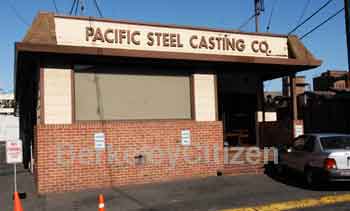 “What this data points out is that people who are living there have a very strong likelihood of being exposed to chronic levels of manganese and nickel,” said Mark Chernaik, a scientist at the Environmental Law Alliance Worldwide, a nonprofit network of environmental lawyers and scientists that analyzed the data. He emphasized that the results are preliminary and merit “a more expansive study.”
“What this data points out is that people who are living there have a very strong likelihood of being exposed to chronic levels of manganese and nickel,” said Mark Chernaik, a scientist at the Environmental Law Alliance Worldwide, a nonprofit network of environmental lawyers and scientists that analyzed the data. He emphasized that the results are preliminary and merit “a more expansive study.”
Foundry spokesperson Elisabeth Jewel said the company is working to decrease emissions and installed a carbon absorption system in one of its plants last September, among other improvements. An additional filtration system will be installed by the end of the week, she said. “They are the best technology available,” Jewel said.
The study was funded by the Bay Area Air Quality Management District, which settled a lawsuit over emissions with Pacific Steel in May. The foundry also settled a lawsuit with Communities for a Better Environment in March. Pacific Steel has conducted its own environmental assessment, which Jewel said will be submitted to the Air District in September.
The new data cannot be easily generalized because the samples were focused in downwind areas and were measured during periods of only 24 hours, Chernaik said. Another major limiting factor in the study was the rooftop method of obtaining samples, said Denny Larson, the executive director of Global Community Monitor.
Nonetheless, the study was procedurally sound and was conducted according to standards suggested by the California Environmental Protection Agency, Chernaik said. The preliminary data suggests that the airborne metals are concentrated near the foundry. One sample a block east of San Pablo Avenue and about a mile northwest of the Berkeley campus found very low levels of manganese and no detectable nickel concentration.
According to the California Environmental Protection Agency, exposure to nickel can exacerbate asthma and exposure to manganese can lead to fatigue, worsened short-term memory and other neurological problems. The study also measured levels of lead, zinc, chromium and copper, but data show that those substances were emitted in much smaller amounts than manganese and nickel.
Larson said it is important to expand the study because these airborne metals do not leave the human system after it is absorbed. “It’s not excreted, it’s not sweated out, it doesn’t come out when you go to the bathroom,” he said. “It’s bioaccumulative.”
A final report will be released by the end of September, Larson said.
Berkeley's Pacific Steel foundry emitting toxic metals, group say
Carolyn Jones, San Francisco Chronicle August 29, 2007 |
A Berkeley steel plant continues to spew toxic levels of manganese, nickel and other metals over residential areas of West Berkeley despite the company's recent steps to reduce emissions, a community group said Tuesday.
 The Berkeley Community Monitoring Team, using a $25,000 grant from the regional air district, based its conclusions on 22 air samples taken from 12 sites within one-third of a mile of the steel foundry.
The Berkeley Community Monitoring Team, using a $25,000 grant from the regional air district, based its conclusions on 22 air samples taken from 12 sites within one-third of a mile of the steel foundry.
Pacific Steel Casting, the nation's third-largest steel foundry and a fixture in West Berkeley for 75 years, agreed earlier this year to install filters on its smokestacks, remove plastic from its scrap supply and take other steps to reduce emissions as part of a settlement of lawsuits filed by the Bay Area Air Quality Management District and an Oakland environmental group.
Pacific Steel has reported what chemicals and metals are released in its manufacturing process, but the community's test is the first look at what residents are inhaling, the group said.
According to the group's data, which span a period of three months, Pacific Steel emitted levels of manganese and nickel more than 10 times higher than what is deemed safe by the World Health Organization. Local and state regulatory agencies do not regulate emission of the metals.
Pacific Steel released almost 700 pounds of manganese and 56 pounds of nickel in 2005, according to figures the foundry gave the air district.
Manganese, a metal found in trace amounts in drinking water and many foods, is safe in small amounts. But high levels of manganese can cause slow and clumsy body movements, poor balance, respiratory problems and sexual dysfunction. High levels of nickel can cause chronic bronchitis and lung problems.
A Pacific Steel spokeswoman said the community group's data is inconclusive and misleading because it's impossible to isolate the steel plant's emissions from other pollution sources in the neighborhood, such as Interstate 80, an asphalt factory and other nearby industries. Pacific Steel is at 1421 Second St., near Gilman Street.
"It's very difficult to point the finger solely at Pacific Steel," company spokeswoman Elisabeth Jewel said.
Pacific Steel is working hard to comply with air district pollution standards, she said. The company recently installed a new filter on the smokestack at Plant No. 1, started using a less toxic binder for mixing the steel, and added a new hood on the furnace at Plant No. 3.
 Berkeley Group Concerned Over Air Conditions From Steel Plant VIDEO
Berkeley Group Concerned Over Air Conditions From Steel Plant VIDEO
Steel Plant Calls Study Inconclusive
Amy Hollyfield
Aug. 28, 2007 (KGO) - A community group has revealed air sample results taken downwind of a Berkeley steel plant. They say the plant is putting neighbor's health in jeopardy but do bay area air quality officials agree.
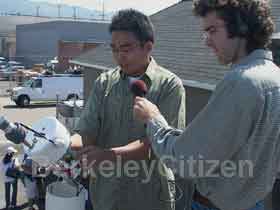 There are questions about how these volunteers took their samples and if the level of contaminants they found are accurate. The volunteers say you can argue the methodology all you want, but the fact that any contaminants were found, raises enough concern for them about peoples health in the community.
There are questions about how these volunteers took their samples and if the level of contaminants they found are accurate. The volunteers say you can argue the methodology all you want, but the fact that any contaminants were found, raises enough concern for them about peoples health in the community.
A team of Berkeley residents took a Minivol portable air sampler and placed it on rooftops in West Berkeley. They've been doing this since April-each time leaving it there for 24 hours.
"We found not so surprisingly high metal emissions particulates that of manganese and nickel," said L A Wood of the Berkeley Air Monitoring Team.
There were days when the levels were below federal and state standards. But the average value of emissions found exceed regulations set by the Environmental Protection Agency and the World Health Organization. The average amounts are within California standards.
The Bay Area Air Quality Management District calls the results preliminary. The district gave the grant for this study, but says the monitoring team has yet to turn a report detailing how the samples were taken, so the district cannot verify the result yet.
The Pacific Steel Company also has problems with this report. They call the test results inconclusive and misleading.
There are numerous numbers of industries around here that may emit and do emit and so there's no way, unless you do source testing right at the source that you can determine what the actual source is.
But a professor of environmental engineering at UC Berkeley looked at the results and says the reported levels warrant a closer look at the steel company.
"To have a steel operation located immediately upwind from a densely populated urban area isn't the best arrangement and yet there are jobs at this site and there's en economic benefit from having the facility there for the city of Berkeley " said Bill Nazaroff, UC Berkeley professor.
Copyright 2007, ABC7/KGO-TV/DT.
Group says Berkeley foundry is spewing toxic metals into air
Traces can cause cancer, neurological disorders
Doug Oakley East Bay Daily News , August 29, 2007 |
Pacific Steel Casting is showering West Berkeley's skies with toxic metal traces that can cause cancer and neurological problems, according to a group of activists who have been monitoring air around the plant since May.
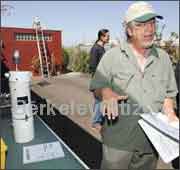 Global Community Monitor, a nonprofit environmental justice group based in San Francisco, started monitoring the air with a $25,000 grant from the Bay Area Air Quality Management District.
Global Community Monitor, a nonprofit environmental justice group based in San Francisco, started monitoring the air with a $25,000 grant from the Bay Area Air Quality Management District.
The group released preliminary data Tuesday from 12 air monitoring sites around Pacific Steel Casting, which has been making steel parts such as fire hydrants, truck parts and bridge pieces in Berkeley since 1934. It found levels of manganese and nickel much higher than those deemed safe by the World Health Organization and the U.S. Environmental Protection Agency.
(Photo: Doug Oakley / Daily News. Denny Larson, director of Global Community Monitor, speaks at a press conference in Berkeley on Monday to announce preliminary data on air pollution around Pacific Steel Casting, a steel foundry near Interstate 80 in Berkeley. At left is one of the devices the group uses to monitor the air.)
The group plans to continue monitoring through December, said director Denny Larson.
"We knew there was a long list of complaints from the plant, but we didn't know if people were being exposed to toxic levels of pollution, and now we have the data," said Peter Guerrero, a consultant working with Larson. "The state of California and the city should look at an industrial relocation plan for them. Just because they have been here for decades doesn't excuse their behavior."
Larson and Guerrero called on Pacific Steel to shut down the plant or install additional pollution-control devices. The plant installed a $4 million filtration device in October 2006 at one of its three buildings and is looking at updating two others. Global Community Monitor also wants to put its own monitoring devices right on Pacific Steel's smokestacks to get more accurate air readings.
Pacific Steel spokeswoman Elizabeth Jewel said closing the plant and moving out of Berkeley is a "completely unrealistic" option.
"That would be a huge loss for the city of Berkeley," Jewel said. "Where would they like us to go?"
Jewel said she can't comment on Global Community Monitor's proposal to install monitoring devices on the plant's smokestacks because Pacific Steel hasn't heard about it yet.
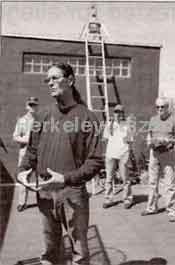 The group said it found concentrations of manganese, which can cause neurological problems similar to Parkinson's disease, and nickel, which can cause cancer, in the air at five sites near the plant.
The group said it found concentrations of manganese, which can cause neurological problems similar to Parkinson's disease, and nickel, which can cause cancer, in the air at five sites near the plant.
Those levels were found in the air as far as six blocks from the plant at Second and Gilman streets.
Larson said the group tested the air for metal traces Pacific Steel has admitted it releases in its steel-making process. In a report to the Bay Area Air Quality Management District, Pacific Steel said it released 529 pounds of manganese and 19 pounds of nickel into the air during a one-year period in 2005 and 2006.
(Photo: Community volunteers with the West Berkeley monitoring group track the local air pollution near Pacific Steel Casting in Berkeley. The press conference was called to announce the findings from the prelimilary data. A roof top monitor device can be seen on the house in the rear. (Doug Oakley)
Jewel said the data released Monday by the Global Community Monitor lacks what counts most - science.
"This is a group of concerned citizens who are not scientists, with no scientific training, who are coming to conclusions that can't be supported," Jewel said. "They don't follow any standard scientific methodology. They don't publish their methodology or how they came to those numbers, there's no peer review and there's no way to say definitively that the source is Pacific Steel."
Karen Schkolnick, spokeswoman for the Bay Area Air Quality Management District, which provided the grant money for the air monitoring, said the district and Global Community Monitor agreed on a scientific protocol before the grant was awarded. However, the air district can't say whether the data released Monday is reliable because the group has not provided a "report that would document how they would handle quality assurance.
"Until then, it's premature to judge the data because we don't know what we're looking at," Schkolnick said. "It was our expectation we would receive that information when we received the data. We can't verify their data until we know what their process is."
Schkolnick said the district grant was awarded so the air could be temporarily monitored until a permanent air monitoring system is installed. She said that monitor will go live in about a month, but added that she can't reveal its location.
Schkolnick said the air district received 533 complaints about Pacific Steel in 2005 and 900 complaints in 2006.
Linda Maio, the Berkeley city council member whose district includes the plant, said she had not seen the report by the environmentalists but isn't surprised by Pacific Steel's reaction.
"It's always easy to say off the cuff that the science isn't good," Maio said.
Although she wants the plant to clean up its act, Maio said she doesn't want to shut it down.
"My first priority is protecting the public from harmful emissions," Maio said. "At the same time we can't just knee-jerk and shut them down. We are trying not to jeopardize the 500 or 600 families that rely on the jobs from this plant."
BERKELEY: Report Shows High Levels of Toxic Metals in Air Near Steel Plant
Bay City News August 29, 2007 |
BERKELEY (BCN)
Air samples taken near a Berkeley steel plant show that levels of toxic metals in the area are hundreds of times higher than the World Health Organization deems safe, according to preliminary results of a study released today.
The air tests taken near Pacific Steel Casting Co. show high levels of nickel and manganese, according to independent health expert Mark Cherniak, who analyzed the data compiled by Berkeley Community Monitoring Team, a group of residents trained to carry out scientific testing.
"In general, the test results are inconclusive and misleading," Pacific Steel Casting spokeswoman Elisabeth Jewel said in a prepared statement.
Berkeley Community Monitoring Team's test doesn't discriminate among the other potential sources of emissions in the West Berkeley area including train tracks, Interstate Highway 80 and other nearby facilities, according to Pacific Steel Casting.
Furthermore, the health-based standards identified in the report represent concentrations associated with long-term exposures, which are not an appropriate comparison to short-term sample durations like the 24-hour samples collected by the monitoring team, according to the company.
The study started May 20 and is expected to continue through at least December, said Denny Larson, executive director of Global Community Monitor, a nonprofit organization that trains industrial communities to keep their neighborhoods clean by doing things like this test by Berkeley Community Monitoring Team.
So far, 24 air samples have been taken. The Berkeley Community Monitoring Team plans to take another 100 samples. To meet Environmental Protection Agency criteria, all sampling is done on rooftops, Larson said.
"This is the first time that this type of detailed monitoring has ever been done," he said.
The grant for the study was provided Bay Area Air Quality Management District, Chairman Mark Ross said.
The preliminary results of the study haven't been vetted so it is not possible to comment on them officially, Ross said.
"We have been in litigation with Pacific Steel and the public has been at odds with the firm for years," Ross said.
High levels of airborne manganese reportedly can affect motor skills such as holding one's hand steady, maintaining balance and performing fast hand movements, according to the Global Community Monitor. Additionally, high levels of exposure may also cause sexual dysfunction and respiratory problems.
Workers at nickel-processing plants and refineries have experienced reduced lung function and chronic bronchitis.
"The smells, the odors, the burning of the eyes - it is something that doesn't just leave you when you leave the area but it stays with you for hours," said L A Wood, a Berkeley Community Monitoring Team member said. "There is always going to be some severe problems with emissions. It is inherent with the industry."
Pacific Steel officials say they are working on ways to improve air quality and it is analyzing its manufacturing process to try to reduce emissions while maintaining the quality of its products.
"It's an ongoing process," Jewel said today.
The company plans to install a baghouse this week, which is like a filter in a vacuum cleaner that picks up metals as air goes through it.
"It filters out the very metals which the Global Community Monitor report talks about," Jewel said.
Pacific Steel also has installed a new carbon filter on one of the plants, which has made significant reductions in odors and emissions, she said.
In addition, the company is using a new binder, or adhesive-like material, which keeps sand molds together when they cast metal. The binder that holds the sand together has been a focal point for emissions. It is still being tested, but company officials say so far the results have been good.
Pacific Steel Casting, located at 1333 Second St., was founded in 1934 to make steel castings for the U.S. military. Employing more than 600 workers, it is the fourth largest surviving steel foundry in the U.S.
Community Air Monitoring of Pacific Steel Casting Company
Environmental group tests air near steel plant
|
BERKELEY: Neighbors worry that emissions contain poisonous heavy metals
Doug Oakley, Media News - Contra Costa Times, April 26, 2007
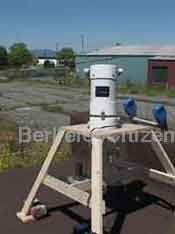 To try to prove that Pacific Steel Casting in Berkeley is showering residents with dangerous heavy metals, a San Francisco group has started monitoring air around the Second Street plant.
To try to prove that Pacific Steel Casting in Berkeley is showering residents with dangerous heavy metals, a San Francisco group has started monitoring air around the Second Street plant.
Meanwhile, the plant has agreed to change an ingredient in its steel-making process that should reduce pollution coming out of its stacks by 2 tons a year, said Adrienne Bloch, staff attorney at Communities for a Better Environment, which sued the steel foundry in federal court last year over violations of the Clean Air Act.
Bloch said that Pacific Steel agreed to change a binder used in sand that forms castings into which molten metal is poured. When that binder gets hot, it releases a smelly emission that Pacific Steel thinks is to blame for most of its complaints.
Pacific Steel also plans to install a new pollution-control device on one of its older plants that should further reduce emissions, Bloch said. The measures resulted from a settlement of the lawsuit that mandated the plant set up a committee of union members, plant managers and Communities for a Better Environment representatives to talk about how it can reduce pollution. "They are taking the settlement very seriously, but there are a lot of things that still need to be done," Bloch said.
Pacific Steel spokeswoman Elisabeth Jewel declined to comment on either the air-monitoring project or the two measures the plant is taking to reduce pollution.
While the plant applies for permits from the Bay Area Air Quality Management District to change its steel-making process, community members now are monitoring the air around the plant through a project funded with a $25,000 air district grant. The equipment and procedures used to monitor the air have the agency's blessing as a credible scientific undertaking, said air district spokeswoman Karen Schkolnick.
 On Monday, Global Community Monitor of San Francisco placed a machine atop the home of Berkeley resident Richard Spencer, who lives about four blocks from Pacific Steel, to start taking 24-hour readings.
On Monday, Global Community Monitor of San Francisco placed a machine atop the home of Berkeley resident Richard Spencer, who lives about four blocks from Pacific Steel, to start taking 24-hour readings.
"We have a long history of complaints related to Pacific Steel," Schkolnick said. "There's been a relationship built over time with the community, and this grant came out of that in addition to the other enforcement and litigation we are pursuing as a comprehensive (pollution-reduction) strategy." She said the district is in the process of installing a permanent air-monitoring device near Pacific Steel but added that it could take years to get it running.
Denny Larson, director of Global Community Monitor, said he wants to use data collected from the air samples to show that Pacific Steel is endangering the health of the community.
"We think Pacific Steel is a serious community health problem in Berkeley, and we want to assign the proper blame to them, which we think is quite large," he said. "We're very dissatisfied with the denial the company is exhibiting on this issue. They are spending a lot of money on public relations rather than cleaning up their act."
He said the air monitoring will be done in 24-hour increments for about four months at eight or 10 other locations in Berkeley. He said he is looking for "marker" metals that he and the air district have identified as specific to Pacific Steel.
Schkolnick said the district will look at the information from the monitoring, but "it's a little premature to say if it will be used for enforcement."
Community Activist L A Wood, who is helping with the monitoring, said the air district is giving the air-monitoring job to a nonprofit group "because it gets (the air district) off the hook. That works for them. Sometimes they have other people do what they can't or won't do."
Spencer, who volunteered the roof of his home for the monitoring device, said he did so because he is worried about his health. He and his son suffer headaches and have trouble sleeping at night, and he thinks the plant's emissions are the reason. The blasts of toxic smell that hit him at different times have driven him to get tested for the presence of heavy metals in his body.
Spencer showed the lab results of a test taken from his hair that showed he is in the 95th percentile for the "potentially toxic elements" of bismuth, cadmium, silver and tin.
"I thought about moving away, but how far do you have to move?" he said. "If I walk around the corner here, immediately I am assailed. The smell comes in blasts, but it is not sustained. The smell suggests toxicity. And the company has been recalcitrant in divulging what those blasts contain."
West Berkeley Residents Monitor Pacific Steel Emissions
By Riya Bhattacharjee Berkeley Daily Planet April 24, 2007
|
A group of West Berkeley residents have set up an air monitor to detect emissions from Pacific Steel Casting (PSC) Monday.
 Setting up an air monitor has been the goal of community members for a long time. Denny Larson, director of the non-profit Global Community Monitor (GCM)—an organization that promotes environmental justice and human rights for communities—helped acquire funds for the project from the Bay Area Air Quality District (BAAQMD).
Setting up an air monitor has been the goal of community members for a long time. Denny Larson, director of the non-profit Global Community Monitor (GCM)—an organization that promotes environmental justice and human rights for communities—helped acquire funds for the project from the Bay Area Air Quality District (BAAQMD).
He was joined in his effort to install the monitor by environmental activists including Steven Ingraham, L A Wood and Peter Guerrero.
“We are putting it up to verify what is in the air,” said Ingraham, a Berkeley resident who tested the equipment. “The community has a right to know.”
Located at 1333 Second St., PSC produces steel castings that are used in different industries. Area residents have complained for years about noxious odors and emissions which they feel impose a health risk.
Ingraham added that the exact location of the air monitor would not be disclosed because it might be tampered with.
“This is an Airmetrics, Mini-vol monitor. It’s state-of-the-art battery-powered and has an electronic programming model which was recommended by the district,” he told the Planet Monday.
“The grant's collaboration parameters have given Denny information on the use, and some of their staff came by to check out our site this morning. We have a rooftop platform which the unit is mounted into and the program was set to begin catching a sample for lab analysis.”
The group hopes to get definite data over the next six months and carry out surveys of illnesses in West Berkeley that have been linked to long-term exposure to chemicals. They are currently looking for more funding.
Air advocates test Pacific Steel site. Group attempts to prove plant odor is toxic
Doug Oakley / East Bay Daily News, April 25, 2007
|
In an attempt to prove that Pacific Steel Casting in Berkeley is showering residents with dangerous heavy metals, a San Francisco group has started monitoring air around the Second Street plant.
Meanwhile, the plant has agreed to change an ingredient in its steel-making process that should reduce pollution coming out of its stacks by two tons a year, said Adrienne Bloch, staff attorney at Communities for a Better Environment, which sued the steel foundry in federal court last year over violations of the Clean Air Act.
Bloch said Pacific Steel agreed to change a binder used in sand that forms castings into which molten metal is poured. When that binder gets hot, it releases a smelly emission that Pacific Steel believes is to blame for most of the complaints.
Pacific Steel also plans to install a new pollution control device on one of its older plants that should further reduce emissions, Bloch said. The measures resulted from a settlement of the lawsuit that mandated the plant set up a committee of union members, plant managers and Communities for a Better Environment representatives to talk about how it can reduce pollution.
"They are taking the settlement very seriously, but there are a lot of things that still need to be done," Bloch said.
Pacific Steel spokeswoman Elisabeth Jewel declined to comment on either the air monitoring project or the two measures the plant is taking to reduce pollution.
While the plant applies for permits from the Bay Area Air Quality Management District to change its steel-making process, community members are now monitoring the air around the plant through a project funded with a $25,000 air district grant. The equipment and procedures used to monitor the air have the agency's blessing as a credible scientific undertaking, said air district spokeswoman Karen Schkolnick.
On Monday, Global Community Monitor of San Francisco placed a machine atop the home of Berkeley resident Richard Spencer, who lives about four blocks from Pacific Steel, to start taking 24-hour readings.
"We have a long history of complaints related to Pacific Steel," Schkolnick said. "There's been a relationship built over time with the community, and this grant came out of that in addition to the other enforcement and litigation we are pursuing as a comprehensive (pollution reduction) strategy."
Schkolnick said the district is in the process of installing a permanent air monitoring device near Pacific Steel but added that it could take years to get it running.
Denny Larson, director of Global Community Monitor, said he wants to use data collected from the air samples to show that Pacific Steel is endangering the health of the community.
"We think Pacific Steel is a serious community health problem in Berkeley and we want to assign the proper blame to them, which we think is quite large," Larson said. "We're very dissatisfied with the denial the company is exhibiting on this issue. They are spending a lot of money on public relations rather than cleaning up their act."
Larson said the air monitoring will be done in 24-hour increments for about four months at eight or 10 locations in Berkeley. He said he is looking for "marker" metals that he and the air district have identified as specific to Pacific Steel.
Schkolnick said the district will look at the information from the project but "it's a little premature to say if it will be used for enforcement."
Community activist L A Wood, who is helping with the monitoring, said the air district is giving the air monitoring job to a nonprofit "because it gets (the air district) off the hook. That works for them. Sometimes they have other people do what they can't or won't do."
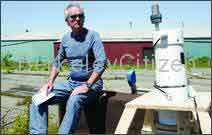 Spencer, who volunteered the roof of his home for the monitoring device, said he did so because he's worried about his health. He and his son suffer headaches and have trouble sleeping at night, and he thinks the plant's smell is the reason. The toxic has driven him to get tested for the presence of heavy metals in his body.
Spencer, who volunteered the roof of his home for the monitoring device, said he did so because he's worried about his health. He and his son suffer headaches and have trouble sleeping at night, and he thinks the plant's smell is the reason. The toxic has driven him to get tested for the presence of heavy metals in his body.
Spencer showed the lab results of a test that showed he is in the 95th percentile for the "potentially toxic elements" of bismuth, cadmium, silver and tin.
"I thought about moving away, but how far do you have to move?" Spencer said. "If I walk around the corner here, immediately I am assailed. The smell comes in blasts, but it is not sustained. The smell suggests toxicity. And the company has been recalcitrant in divulging what those blasts contain."